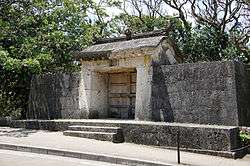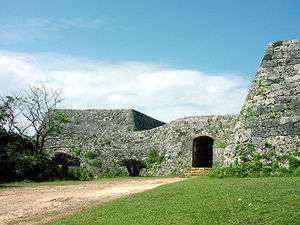Gusuku Sites and Related Properties of the Kingdom of Ryukyu
| Gusuku Sites and Related Properties of the Kingdom of Ryukyu | |
|---|---|
| Name as inscribed on the World Heritage List | |
|
| |
| Type | Cultural |
| Criteria | ii, iii, vi |
| Reference | 972 |
| UNESCO region | Asia-Pacific |
| Inscription history | |
| Inscription | 2000 (24th Session) |
The Gusuku Sites and Related Properties of the Kingdom of Ryukyu (琉球王国のグスク及び関連遺産群 Ryūkyū ōkoku no gusuku oyobi kanren'isangun) is an UNESCO World Heritage Site which consists of nine sites all located in the Okinawa Prefecture, Japan. The heritage sites include two utaki (or sacred sites, one a gate and the other a grove), the Tamaudun mausoleum, one garden, and five gusuku castles sites, four of which are ruins and one of which is a reconstruction. The sites were inscribed based on the criteria that they were a fine representation of the Ryūkyū Kingdom's culture, whose unique blend of Japanese and Chinese influence made it a crucial economic and cultural junction between several neighboring states.[1][2]
History
The construction of the Gusuku began throughout the islands at the end of the shell-mound period and heralded the Gusuku period[3] and the rise of Aji Chieftains at the approach of the 12th century. During this period, people who had been living in coastlines along low-lying areas had moved to higher ground to build villages inland. Agriculture--such as paddy rice, wheat and millet--was developed further during this period. Groves called utaki were constructed within these villages to serve as sacred grounds for praying to guardian spirits of cultivation. Overseas trading was also opened when the Ryukyu Islands began to create a common culture. The existence of Sueki ware and Chinese ceramics excavated in the Amami Islands region is considered as strong evidence of its cultural development. At the beginning of the 13th century, a steady rise in the interests of the villages saw the emergence of chieftains who were called Aji or Anji and who occupied political positions within these villages. The aji mainly oversaw taxes and conducted religious rites. Trade became more developed and allowed the ajis to increase possession of good harbors in Urasoe, Yomitan, Nakagusuku, Katsuren, Sashiki and Nakijin.
The Sanzan kingdoms were formed when the regional aji dealt with struggles to defend their domains as their powers increased. The Ryukyus[4] were divided into 3 kingdoms, the Hokuzan in the north which was situated at Nakijin Gusuku, the Chuzan in the central area which was in Urasoe Gusuku, and Nanzan in the south which was in Shimajiri Ozato. The Eiso Dynasty who came to power in the central Chuzan Kingdom declined during the rise of fourth king Tamagusuku and fifth king Seii. In 1350, Satto ascended to the Chuzan throne where he reigned for 56 years. A legend[5] circulated at this time where it is said that in Urasoe there lived a poor farmer by the name of Okumaufuya. One day he was walking down a road going home, he stopped in the springs of Mori-no-kawa to wash his hands, there he saw a beautiful woman taking a bath in the springs. Okuma immediately hid the woman's clothes and approached her, as it turned out the woman was a celestial maiden. The woman searched for her clothes but Okuma did not say a word that he had hid them, the woman in despair was accompanied her to his house. A couple of years passed and the woman and Okuma had children, a girl and a boy[6] they named Janamoi. One day, the older sister was singing her little brother to sleep with a song about the celestial robe of her mother kept in the outhouse. Their mother heard this and regained her robe this led to the woman saying goodbye to her family. The story suggests that Janamoi grew up to become King Satto.
A significant change in status for the period happened in 1609[7] with the invasion of the Ryukyus by the Satsuma-han of Japan. At this time Satsuma took control of the Ryukyus and placed the northern islands of Amami under direct Satsuma rule. Before this time the Sho dynasty had previously governed over the Ryukyu Kingdom.
Preservation
The world-heritage listing of the "Gusuku Sites and Related Properties of the Kingdom of Ryukyu"[8][9] represents more than 500 years[10][11] of Ryukyuan history, specifically from the 12th to the 17th century. On November 30, 2000, UNESCO inscribed it, along with 60 other global sites, on the World Heritage list. It was selected on the basis of three of the 10 criteria[12][13] set by UNESCO. Specifically, the Gusuku sites were selected for the way that they (1) exhibit the importance of human values over a span of time (Criteria ii), in this case covering more than 500 years of cultural and ethnic history; (2) show an exceptional cultural tradition by a civilization that has disappeared (Criteria iii); and (3) are regarded for tangibly linking events and traditions with ideals and beliefs with literary and artistic works (Criteria vi).
List of sites
| Name | Type | Location | Picture |
|---|---|---|---|
| Tamaudun (玉陵) | Mausoleum | Naha, Okinawa |  |
| Sonohyan-utaki Ishimon (園比屋武御嶽石門, Okinawan: Sunuhwan-utaki) | Stone gate at utaki | Naha, Okinawa |  |
| Nakijin Castle Site (今帰仁城跡 Nakijin-jō ato, Okinawan: Nachizin Gushiku) | Gusuku ruins | Nakijin, Kunigami, Okinawa |  |
| Zakimi Castle Site (座喜味城跡 Zakimi-jō ato, Okinawan: Zachimi Gushiku) | Gusuku ruins | Yomitan, Nakagami, Okinawa |  |
| Katsuren Castle Site (勝連城跡跡 Katsuren-jō ato, Okinawan: Katchin Gushiku) | Gusuku ruins | Uruma, Nakagami, Okinawa |  |
| Nakagusuku Castle Site (中城城跡 Nakagusuku-jō ato, Okinawan: Nakagusiku Gushiku)[14] | Gusuku ruins | Nakagusuku, Nakagami, Okinawa |  |
| Shuri Castle Site (首里城跡 Shuri-jō ato, Okinawan: Sui Gushiku) | Reconstructed Gusuku on site of ruins | Naha, Okinawa |  |
| Shikinaen (識名園) | Garden | Naha, Okinawa |  |
| Sefa-utaki (斎場御嶽 Seefa-utaki) | Utaki | Nanjō, Okinawa |  |
See also
Notes
- Motoo, Hinago (1986). Japanese Castles. Tokyo: Kodansha. pp. 200 pages. ISBN 0-87011-766-1.
- Kerr, George H. (2000). Okinawa: the History of an Island People. (revised ed.) Boston: Tuttle Publishing.
- Smits, Gregory (1999). "Visions of Ryukyu: Identity and Ideology in Early-Modern Thought and Politics." Honolulu: University of Hawai'i Press.
References
- ↑ ICOMOS (25 June 1999). "Advisory Body Evaluation" (PDF). Retrieved 2009-08-01.
- ↑ Agency for Cultural Affairs (2000). "Gusuku Sites and Related Properties of the Kingdom of Ryukyu — World Heritage List Nomination Cultural Property". Retrieved 2009-08-01.
- ↑ "Gusuku Period". Wonder Okinawa. Retrieved 2010-01-21.
- ↑ "The Sanzan Period". Wonder Okinawa. Retrieved 2010-01-21.
- ↑ Okinawan History Chronology. Okinawa rekishi jinmei jiten (沖縄歴史人名事典, "Encyclopedia of People of Okinawan History"). Naha: Okinawa Bunka-sha, 2002. p85.
- ↑ "Islands come alive with fun-filled festivals". Weekly Japan Update. Retrieved 2010-01-21.
- ↑ "Early History of The Ryukyu Kingdom and its Relationship with China and Japan". Shitokai. Retrieved 2010-01-21.
- ↑ "Japan World Heritage Sites". Japan Guide. Retrieved 2010-01-21.
- ↑ "Gusuku Sites and related properties of the kingdom of Ryukyu". JAL Guide. Retrieved 2010-01-21.
- ↑ "WORLD HERITAGE COMMITTEE INSCRIBES 61 NEW SITES ON WORLD HERITAGE LIST". Virtual Heritage. Retrieved 2010-01-21.
- ↑ "Gusuku Sites and Related Properties of the Kingdom of Ryukyu". Trip Wolf.
- ↑ "Criteria for Selection". Unesco. Retrieved 2010-01-21.
- ↑ "World Heritage Comm. Enshrines 61 new Sites". Unesco. Retrieved 2010-01-21.
- ↑ Okinawa Prefectural reserve cultural assets center (2015). "ふたつの中城御殿跡". Comprehensive Database of Archaeological Site Reports in Japan. Retrieved 2016-09-02.
External links
![]() Media related to Gusuku sites and related properties of the Kingdom of Ryukyu at Wikimedia Commons
Media related to Gusuku sites and related properties of the Kingdom of Ryukyu at Wikimedia Commons
- Gusuku Sites and Related Properties of the Kingdom of Ryukyu at UNESCO
- Gusuku Sites Type and the Related Properties of the Kingdom of Ryukyu at Wonder Okinawa
- Comprehensive Database of Archaeological Site Reports in Japan, Nara National Research Institute for Cultural Properties
